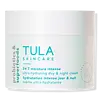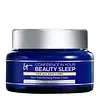What's inside
What's inside
 Key Ingredients
Key Ingredients

 Benefits
Benefits

 Concerns
Concerns

 Ingredients Side-by-side
Ingredients Side-by-side

Water
Skin ConditioningButyrospermum Parkii Butter
Skin ConditioningPropanediol
SolventGlycerin
HumectantDicaprylyl Carbonate
EmollientJojoba Esters
EmollientCamellia Japonica Seed Oil
EmollientLactococcus Ferment Lysate
Skin ConditioningGlyceryl Stearate
EmollientCetearyl Alcohol
EmollientAmmonium Acryloyldimethyltaurate/Beheneth-25 Methacrylate Crosspolymer
Emulsion StabilisingMyristyl Myristate
EmollientSqualane
EmollientPolyacrylate Crosspolymer-6
Emulsion StabilisingHyaluronic Acid
HumectantCollagen
MoisturisingHippophae Rhamnoides Oil
EmollientArgania Spinosa Kernel Oil
EmollientLinoleic Acid
CleansingLinolenic Acid
CleansingHydrolyzed Rice Protein
Skin ConditioningLactobacillus
Skin ConditioningLactobacillus Ferment
Skin ConditioningCichorium Intybus Root Extract
MaskingCitrullus Lanatus Fruit Extract
Skin ConditioningPyrus Malus Fruit Extract
Skin ConditioningCurcuma Longa Root Extract
MaskingLactic Acid
BufferingVaccinium Angustifolium Fruit Extract
Skin ProtectingBeta Vulgaris Root Extract
Skin ConditioningTocopheryl Acetate
AntioxidantInulin
Skin ConditioningPolymnia Sonchifolia Root Juice
Skin ConditioningAlpha-Glucan Oligosaccharide
CleansingAscorbyl Palmitate
AntioxidantLens Esculenta Fruit Extract
Skin ConditioningSodium PCA
HumectantLeuconostoc/Radish Root Ferment Filtrate
AntimicrobialButylene Glycol
HumectantCandelilla/Jojoba/Rice Bran Polyglyceryl-3 Esters
EmulsifyingCaprylyl Glycol
EmollientCetearyl Olivate
Maltodextrin
AbsorbentPentylene Glycol
Skin ConditioningPotassium Sorbate
PreservativeSodium Benzoate
MaskingSodium Chloride
MaskingSodium Phytate
Polysorbate 60
EmulsifyingSodium Stearoyl Lactylate
EmulsifyingParfum
MaskingWater, Butyrospermum Parkii Butter, Propanediol, Glycerin, Dicaprylyl Carbonate, Jojoba Esters, Camellia Japonica Seed Oil, Lactococcus Ferment Lysate, Glyceryl Stearate, Cetearyl Alcohol, Ammonium Acryloyldimethyltaurate/Beheneth-25 Methacrylate Crosspolymer, Myristyl Myristate, Squalane, Polyacrylate Crosspolymer-6, Hyaluronic Acid, Collagen, Hippophae Rhamnoides Oil, Argania Spinosa Kernel Oil, Linoleic Acid, Linolenic Acid, Hydrolyzed Rice Protein, Lactobacillus, Lactobacillus Ferment, Cichorium Intybus Root Extract, Citrullus Lanatus Fruit Extract, Pyrus Malus Fruit Extract, Curcuma Longa Root Extract, Lactic Acid, Vaccinium Angustifolium Fruit Extract, Beta Vulgaris Root Extract, Tocopheryl Acetate, Inulin, Polymnia Sonchifolia Root Juice, Alpha-Glucan Oligosaccharide, Ascorbyl Palmitate, Lens Esculenta Fruit Extract, Sodium PCA, Leuconostoc/Radish Root Ferment Filtrate, Butylene Glycol, Candelilla/Jojoba/Rice Bran Polyglyceryl-3 Esters, Caprylyl Glycol, Cetearyl Olivate, Maltodextrin, Pentylene Glycol, Potassium Sorbate, Sodium Benzoate, Sodium Chloride, Sodium Phytate, Polysorbate 60, Sodium Stearoyl Lactylate, Parfum
Water
Skin ConditioningDimethicone
EmollientGlycerin
HumectantSimmondsia Chinensis Seed Oil
EmollientHydrogenated Castor Oil Dimer Dilinoleate
Skin ConditioningPropanediol
SolventAlcohol Denat.
AntimicrobialCaprylic/Capric Triglyceride
MaskingCetyl Alcohol
EmollientCetyl Hydroxyethylcellulose
Emulsion StabilisingOctyldodecanol
EmollientSilica
AbrasivePhenoxyethanol
PreservativeAlbizia Julibrissin Bark Extract
MaskingCaprylyl Glycol
EmollientParfum
MaskingPoloxamer 338
EmulsifyingCapryloyl Salicylic Acid
ExfoliatingLimonene
PerfumingAdenosine
Skin ConditioningTocopherol
AntioxidantXanthan Gum
EmulsifyingDisodium EDTA
Linalool
PerfumingCeramide NP
Skin ConditioningHydroxypalmitoyl Sphinganine
Skin ConditioningSilica Dimethyl Silylate
EmollientHydrated Silica
AbrasiveSodium Hyaluronate
HumectantPolysorbate 60
EmulsifyingCitronellol
PerfumingSodium Benzoate
MaskingCI 16035
Cosmetic ColorantGeraniol
PerfumingCereus Grandiflorus Flower Extract
Skin ConditioningCitral
PerfumingDarutoside
Skin ConditioningCI 42090
Cosmetic ColorantGlucose
HumectantLactic Acid
BufferingPotassium Sorbate
PreservativeWater, Dimethicone, Glycerin, Simmondsia Chinensis Seed Oil, Hydrogenated Castor Oil Dimer Dilinoleate, Propanediol, Alcohol Denat., Caprylic/Capric Triglyceride, Cetyl Alcohol, Cetyl Hydroxyethylcellulose, Octyldodecanol, Silica, Phenoxyethanol, Albizia Julibrissin Bark Extract, Caprylyl Glycol, Parfum, Poloxamer 338, Capryloyl Salicylic Acid, Limonene, Adenosine, Tocopherol, Xanthan Gum, Disodium EDTA, Linalool, Ceramide NP, Hydroxypalmitoyl Sphinganine, Silica Dimethyl Silylate, Hydrated Silica, Sodium Hyaluronate, Polysorbate 60, Citronellol, Sodium Benzoate, CI 16035, Geraniol, Cereus Grandiflorus Flower Extract, Citral, Darutoside, CI 42090, Glucose, Lactic Acid, Potassium Sorbate
 Reviews
Reviews

Ingredients Explained
These ingredients are found in both products.
Ingredients higher up in an ingredient list are typically present in a larger amount.
Caprylyl Glycol is a humectant and emollient, meaning it attracts and preserves moisture.
It is a common ingredient in many products, especially those designed to hydrate skin. The primary benefits are retaining moisture, skin softening, and promoting a healthy skin barrier.
Though Caprylyl Glycol is an alcohol derived from fatty acids, it is not the kind that can dry out skin.
This ingredient is also used as a preservative to extend the life of products. It has slight antimicrobial properties.
Learn more about Caprylyl GlycolGlycerin is already naturally found in your skin. It helps moisturize and protect your skin.
A study from 2016 found glycerin to be more effective as a humectant than AHAs and hyaluronic acid.
As a humectant, it helps the skin stay hydrated by pulling moisture to your skin. The low molecular weight of glycerin allows it to pull moisture into the deeper layers of your skin.
Hydrated skin improves your skin barrier; Your skin barrier helps protect against irritants and bacteria.
Glycerin has also been found to have antimicrobial and antiviral properties. Due to these properties, glycerin is often used in wound and burn treatments.
In cosmetics, glycerin is usually derived from plants such as soybean or palm. However, it can also be sourced from animals, such as tallow or animal fat.
This ingredient is organic, colorless, odorless, and non-toxic.
Glycerin is the name for this ingredient in American English. British English uses Glycerol/Glycerine.
Learn more about GlycerinLactic Acid is another well-loved alpha hydroxy acid (AHA). It is gentler than glycolic acid but still highly effective.
Its main role is to exfoliate the surface of the skin by loosening the “glue” that holds dead skin cells together. Shedding those old cells leads to smoother, softer, and more even-toned skin.
Because lactic acid molecules are larger than glycolic acid, they don’t penetrate as deeply. This means they’re less likely to sting or irritate, making it a great choice for beginners or those with sensitive skin.
Like glycolic acid, it can:
Lactic acid also acts as a humectant (like hyaluronic acid). It can draw water into the skin to improve hydration and also plays a role in the skin's natural moisturizing factor (NMF) in the form of sodium lactate.
Studies show it can boost ceramide production to strengthen the skin barrier and even help balance the skin’s microbiome.
To get results, choose products with a pH between 3-4.
Lower strengths (5-12%) focus on surface exfoliation; higher strengths (12% and up) can reach deeper in the dermis (deeper, supportive layer) to improve skin texture and firmness over time.
Though it was originally derived from milk, most modern lactic acid used in skincare is vegan. It is made through non-dairy fermentation to create a bio-identical and stable form suitable for all formulations.
When lactic acid shows up near the end of an ingredient list, it usually means the brand added just a tiny amount to adjust the product’s pH.
Legend has it that Cleopatra used to bathe in sour milk to help reduce wrinkles.
Lactic acid is truly a gentle multitasker: it exfoliates, hydrates, strengthens, and brightens. It's a great ingredient for giving your skin a smooth, glowing, and healthy look without the harshness of stronger acids.
Read more about some other popular AHA's here:
Learn more about Lactic AcidParfum is a catch-all term for an ingredient or more that is used to give a scent to products.
Also called "fragrance", this ingredient can be a blend of hundreds of chemicals or plant oils. This means every product with "fragrance" or "parfum" in the ingredients list is a different mixture.
For instance, Habanolide is a proprietary trade name for a specific aroma chemical. When used as a fragrance ingredient in cosmetics, most aroma chemicals fall under the broad labeling category of “FRAGRANCE” or “PARFUM” according to EU and US regulations.
The term 'parfum' or 'fragrance' is not regulated in many countries. In many cases, it is up to the brand to define this term.
For instance, many brands choose to label themselves as "fragrance-free" because they are not using synthetic fragrances. However, their products may still contain ingredients such as essential oils that are considered a fragrance by INCI standards.
One example is Calendula flower extract. Calendula is an essential oil that still imparts a scent or 'fragrance'.
Depending on the blend, the ingredients in the mixture can cause allergies and sensitivities on the skin. Some ingredients that are known EU allergens include linalool and citronellol.
Parfum can also be used to mask or cover an unpleasant scent.
The bottom line is: not all fragrances/parfum/ingredients are created equally. If you are worried about fragrances, we recommend taking a closer look at an ingredient. And of course, we always recommend speaking with a professional.
Learn more about ParfumPolysorbate 60 is used to help stabilize products. It is a surfactant and emulsifier. These properties help keep ingredients together in a product. Surfactants help reduce surface tension between ingredients with different states, such as liquids and solids. Emulsifiers help prevent oils and waters from separating.
Polysorbate 60 is sorbitol-based and created from the ethoxylation of sorbitan. Ethoxylation is a chemical reaction used to add ethylene oxide. Sorbitan is a the dehydrated version of sorbitol, a sugar found in fruits.
In this case, the 60 comes from reacting 60 units of ethylene oxide with sorbitan.
Polysorbates are commonly used in medicine and foods.
Learn more about Polysorbate 60Potassium Sorbate is a preservative used to prevent yeast and mold in products. It is commonly found in both cosmetic and food products.
This ingredient comes from potassium salt derived from sorbic acid. Sorbic acid is a natural antibiotic and effective against fungus.
Both potassium sorbate and sorbic acid can be found in baked goods, cheeses, dried meats, dried fruit, ice cream, pickles, wine, yogurt, and more.
You'll often find this ingredient used with other preservatives.
Learn more about Potassium SorbatePropanediol is an all-star ingredient. It softens, hydrates, and smooths the skin.
It’s often used to:
Propanediol is not likely to cause sensitivity and considered safe to use. It is derived from corn or petroleum with a clear color and no scent.
Learn more about PropanediolSodium Benzoate is a preservative. It's used in both cosmetic and food products to inhibit the growth of mold and bacteria. It is typically produced synthetically.
Both the US FDA and EU Health Committee have approved the use of sodium benzoate. In the US, levels of 0.1% (of the total product) are allowed.
Sodium benzoate works as a preservative by inhibiting the growth of bacteria inside of cells. It prevents the cell from fermenting a type of sugar using an enzyme called phosphofructokinase.
It is the salt of benzoic acid. Foods containing sodium benzoate include soda, salad dressings, condiments, fruit juices, wines, and snack foods.
Studies for using ascorbic acid and sodium benzoate in cosmetics are lacking, especially in skincare routines with multiple steps.
We always recommend speaking with a professional, such as a dermatologist, if you have any concerns.
Learn more about Sodium BenzoateWater. It's the most common cosmetic ingredient of all. You'll usually see it at the top of ingredient lists, meaning that it makes up the largest part of the product.
So why is it so popular? Water most often acts as a solvent - this means that it helps dissolve other ingredients into the formulation.
You'll also recognize water as that liquid we all need to stay alive. If you see this, drink a glass of water. Stay hydrated!
Learn more about Water